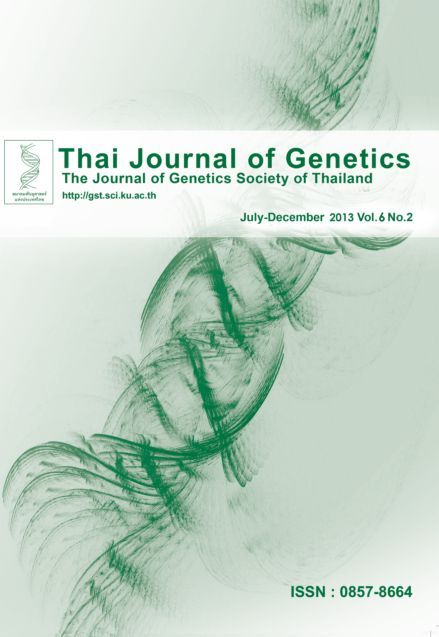ความแปรปรวนทางพันธุกรรมในประชากรปลายี่สกเทศของไทยที่มาจากการเพาะเลี้ยง ปรับปรุงพันธุ์ และแหล่งน้ำธรรมชาติ
DOI:
https://doi.org/10.14456/tjg.2013.143Keywords:
Rohu (Labeo rohita), genetic variation, microsatelliteAbstract
ดำเนินการวิเคราะห์ความแปรปรวนทางพันธุกรรมในประชากรปลายี่สกเทศของไทยที่มาจากการเพาะเลี้ยงและปรับปรุงพันธุ์ ได้แก่ ประชากรจากศูนย์วิจัยและพัฒนาประมงน้ำจืดกาฬสินธุ์ และศูนย์วิจัยและพัฒนาพันธุกรรมสัตว์น้ำอุตรดิตถ์ 4 ประชากร (P0, F1, F2 และ F3) และประชากรจากธรรมชาติ ได้แก่ แม่น้ำมูล จังหวัดอุบลราชธานี บึงสีไฟ จังหวัดพิจิตร และแม่น้ำเมย จังหวัดตาก โดยใช้เทคนิคเครื่องหมายพันธุกรรมไมโครแซทเทลไลท์ จำนวน 8 ตำแหน่ง ได้ข้อมูลความแปรปรวนหรือความหลากหลายทางพันธุกรรม ซึ่งประกอบด้วยค่าเฉลี่ยต่อตำแหน่งของ จำนวนแอลลีลที่ปรากฏ (Aa = 2.1250 – 3.2500), effective number of alleles (Ae = 1.6342 – 2.2075), allelic richness (Ar = 2.0696 – 2.7714), ค่าสังเกตเฮเทอโรไซโกซิตี (Ho = 0.3183 – 0.5303) และค่าคาดคะเนเฮเทอโรไซโกซิตี (He = 0.3209 – 0.5031) ปริมาณความแปรปรวนทางพันธุกรรมของทุกประชากรอยู่ในระดับเดียวกัน หรือไม่แตกต่างกันในทุกประชากร (P>0.05) และทุกประชากรไม่เบี่ยงเบนจากสมดุลฮาร์ดี-ไวน์เบิร์ก (PHWE>0.05) ค่า effective population size (Ne) ที่ประเมินในแต่ละประชากรอยู่ระหว่าง 1.5 – 109.5 โดยค่าต่ำสุดอยู่ที่ประชากรจากศูนย์วิจัยและพัฒนาประมงน้ำจืดกาฬสินธุ์ ซึ่งสมควรได้รับการเอาใจใส่ดูแลอย่างเคร่งครัด การวิเคราะห์ความแตกต่างระหว่างประชากร ระบุว่า ประชากรทั้งหมดอยู่ในกลุ่มเดียวกัน โดยมีความแตกต่างระหว่างประชากรที่อยู่ภายในกลุ่มเดียวกันนี้ และเมื่อวิเคราะห์ความแตกต่างในทุกคู่ประชากร พบว่า ประชากรจากศูนย์วิจัยและพัฒนาประมงน้ำจืดกาฬสินธุ์ แม่น้ำมูล บึงสีไฟ และแม่น้ำเมย ไม่มีความแตกต่างกัน (PFst>0.0007, Bonferroni correction) และยังสนับสนุนว่าประชากรเหล่านี้อยู่ในกลุ่มที่สืบทอดหรือมีความใกล้ชิดกับประชากรที่นำเข้าในช่วงปี 2511-2512 นอกจากนี้ จากการวิเคราะห์โครงสร้างความสัมพันธ์ระหว่างประชากรที่พบว่า ประชากร P0, F1, F2 และ F3 ในโปรแกรมการคัดเลือกปรับปรุงพันธุ์ของศูนย์วิจัยและพัฒนาพันธุกรรมสัตว์น้ำอุตรดิตถ์ มีความสัมพันธ์ที่ใกล้ชิดกันมากกว่ากับประชากรอื่น เป็นการยืนยันต้นกำเนิดของประชากรดังกล่าวว่ามาจากประชากรเดียวกันที่นำเข้าในช่วงปี 2541
ผลการศึกษาโดยการเปรียบเทียบระหว่างรุ่นประชากร ด้วยข้อมูลทางพันธุกรรมจากการศึกษาครั้งนี้ และข้อมูลลักษณะการเจริญเติบโตที่มีการรายงานไว้ก่อนหน้านี้ ระบุว่า การปรับปรุงพันธุ์ปลายี่สกเทศโดยการคัดเลือกแบบหมู่ของ ศพก.อุตรดิตถ์ ตั้งแต่รุ่น P0 ถึง F3 มีผลให้ปลายี่สกเทศรุ่น F2 มีการเจริญเติบโตเพิ่มขึ้นมากกว่ารุ่นที่ผ่านมา ในขณะที่พันธุกรรมของประชากรเริ่มมีความแตกต่างออกไปจากรุ่นพ่อแม่ (P0) ในรุ่น F3 จึงแนะนำว่าควรให้ความสนใจในเรื่องการบริหารจัดการพันธุกรรมของประชากรพ่อแม่พันธุ์ให้มากขึ้นหลังจากการคัดเลือกผ่านรุ่น F3 ไปแล้ว
References
ชวลิต วิทยานนท์ จรัลธาดา กรรณสูต และ จารุจินต์ นภีตะภัฏ. 2540. ความหลากชนิดของปลาน้ำจืดในประเทศไทย. สำนักงานนโยบายและแผนสิ่งแวดล้อม กรุงเทพฯ.
พนม กระจ่างพจน์ สอดศุข ศรีรัตน์ สอดศุข ธนัญช์ สังกรธนกิจ พลชาติ ผิวเณร และ ภูวนัย ชัยศรี. 2552. ความหลากหลายทางพันธุกรรมและความแตกต่างระหว่างประชากรในปูม้าจากแหล่งธรรมชาติของไทย โดยใช้เทคนิคไมโครแซทเทลไลท์และการเปรียบเทียบลักษณะการเจริญเติบโต. เอกสารวิชาการฉบับที่ 10/2552 สถาบันวิจัยและพัฒนาพันธุกรรมสัตว์น้ำ กรมประมง กระทรวงเกษตรและสหกรณ์.
พนม กระจ่างพจน์ สอดศุข สุภัทรา อุไรวรรณ์ และ ศรีรัตน์ สอดศุข. 2548. วิเคราะห์ความแปรปรวนทางพันธุกรรมโดยใช้โมเลกุลเครื่องหมายในกระบวนการคัดเลือกปรับปรุงพันธุ์กุ้งกุลาดำ. เอกสารวิชาการฉบับที่ 5/2548 สถาบันวิจัยและพัฒนาพันธุกรรมสัตว์น้ำ กรมประมง กระทรวงเกษตรและสหกรณ์.
อภิชาต เติมวิชชาการ ชวลิต วิทยานนท์ ยู่อี้ เกตเพชร ประเทศ ซอรักษ์ และ
ประเสริฐ ภราดรพานิชกุล. 2546. สัตว์น้ำต่างถิ่นในประเทศไทย. เอกสารเผยแพร่สำนักบริหารจัดการด้านการประมง ร่วมกับสถาบันวิจัยและพัฒนาทรัพยากรประมงน้ำจืด กรมประมง กระทรวงเกษตรและสหกรณ์.
Alam, M.S., Jahan, M., Hossain, M.M. and Islam, M.S. 2009. Population genetic structure of three major river populations of Rohu, Labeo rohita (Cyprinidae: Cyprinoformes) using microsatellite DNA markers. Genes & Genomics 31: 43-51.
Allendorf, F.W. 1986. Genetic drift and the loss of alleles versus heterozygosity. Zoo. Biol. 5: 181-190.
Alonso, S. and Armour, J.A.L. 2001. A highly variable segment of human subterminal 16p reveals a history of population growth for modern humans outside Africa. Proc Natl Acad Sci USA 98: 864–869.
Boom, R., Sol, C.J.A., Salimans, M.M.M., Jansen, C.L.,
Wertheim-van Dillen, P.M.E. and Van der Noordaa, J. 1990. Rapid and simple methods for purification of nucleic acids. Journal of Clinical Microbiology 28: 495-503.
Das, P., Barat, A., Meher, P.K., Ray, P.P. and Majumdar, D. 2005. Isolation and characterization of polymorphic microsatellites in Labeo rohita and their cross-species amplification in related species. Molecular Ecology Notes 5, 231-233.
Duangswasdi, S. and Pupipat, T. 1982. Summary on life history of introduced fish species. Technical Paper No. 7. National Inland Fisheries Institute, Freshwater Fisheries Division, Department of Fisheries. (in Thai)
Excoffier, L., Laval, G. and Schneider, S. 2006. Arlequin ver 3.1. An Integrated Software Package for Population Genetics Data Analysis. Computational and Molecular Population Genetics Lab (CMPG), Institute of Zoology, University of Berne, Switzerland. (URL: http://cmpg.unibe.ch/software/arlequin3)
Frankham, R., Ballou, J.D., Briscoe, D.A. 2002. Introduction to Conservation Genetics. Cambridge University Press, Cambridge.
Fu, Y.X. 1997. Statistical tests of neutrality of mutations against population growth, hitchhiking and background selection. Genetics 147: 915-925.
Goudet, J. 1995. Fstat version 1.2: a computer program to calculate Fstatistics. Journal of Heredity 86: 485-486.
Holsinger, K.E. 2012. Tajima’s D, Fu’s Fs, Fay and Wu’s H, and Zeng et al.’s E. (URL: http://darwin.eeb.uconn.edu/eeb348/lecture-notes/molevol-tajima.pdf)
Höss, M. 1994. More about the silica method. Ancient DNA Newsletter 2: 10-12.
Höss, M. and Pääbo, S. 1993. DNA extraction from Pleistocene bones by a silica-based purification method. Nucleic Acids Research 21: 3913-3914.
Jhingran, V.G. and Pullin, R.S.V. 1985. A Hatchery Manual for the Common, Chinese and Indian Major Carps. ICLARM Contribution No. 252. The Asian Development Bank and the International Center for Living Aquatic Resources Management, Manila, Philippines.
Kapuscinski, A.R. and Miller, L.M. 2007. Genetic Guidelines for Fisheries Management. Second Edition. University of Minnesota Sea Grant Program, University of Minnesota, USA. (URL: http://www.seagrant.umn.edu/downloads/f22.pdf
Kemp, B.M., Monroe, C. and Smith, D.G. 2006. Repeat silica extraction: a simple technique for the removal of PCR inhibitors from DNA extracts. Journal of Archaeological Science 33: 1680-1689.
Khan, H.A. and Jhingran, V.G. 1975. Synopsis of biological data on Rohu Labeo rohita (Hamilton, 1822). FAO Fisheries Synopsis No. 111. Food and Agriculture Organization of the United Nations, Rome.
Kim, J.E. Withler, R.E, Ritland, C. and Cheng, K.M. 2004. Genetic variation within and between domesticated Chinook salmon, Oncorhynchus tshawytscha, strains and their progenitor populations. Environ. Biol. Fisches 69: 371-378.
Lui, Z.J. and Cordes, J.F. 2004. DNA marker technologies and their applications in aquaculture genetics. Aquaculture 238: 1-37.
Nei, M. 1978. Estimation of average heterozygosity and genetic distance from a small number of individuals. Genetics 89: 583-590.
Norris, A.T., Bradley, D.G. and Cunningham, E.P. 1999. Microsatellite genetic variation between and within farmed and wild Atlantic salmon (Salmo salar) populations. Aquaculture 180: 247-264.
Patel, A., Das, P., Swain, S.K., Meher, P.K., Jayasankar, P. and Sarangi N. 2009. Development of 21 new microsatellite markers in Labeo rohita (rohu). Animal Genetics 40, 251-254.
Purdom, C.E. 1993. Genetics and Fish Breeding. Chapman and Hall, London.
Queller, D.C., Strassmann, J.E. and Hughes, C.R. 1993. Microsatellites and kinship. Tree 8: 285-288.
Ratanatrivong, W., Uraiwan, S., Kongtaratana, S., Kaewchana, S., Utlert, T., and Sukmanomon, S. 2009. Mass selection on growth of rohu (Labeo rohita). Technical Paper No. 7/2009. Aquatic Animal Genetics Research and Development Institute, Department of Fisheries. (in Thai)
Rice, W.R. 1989. Analyzing tables of statistical tests. Evolution 43: 223-225.
Smouse, P.E., Neel, J.V. and Liu. W. 1983. Multiple-locus departures from panmictic equilibrium within and between village gene pools of Amerindian Tribes at different stages of agglomeration. Genetics 104: 133-153.
Sokal, R.R. and Rohlf, F.J. 1981. Biometry. 2nd ed. W.H. Freeman, San Francisco.
SPSS Inc. 1999. SPSS Base 10.0 for Windows User’s Guide. SPSS Inc., Chicago IL.
Tave, D. 1993. Genetics for Fish Hatchery Managers. 2nd edition. Kluwer Academic Publishers, Boston.
Van Oosterhout, C., Hutchinson, B., Wills, D. and Shipley, P. 2004. MICRO-CHECKER: software for identification and correcting genotyping errors in microsatellite data. Mol Ecol Notes 4: 535–538.
Waples, R.S. and Do, C. 2008. LDNE: a program for estimating effective population size from data on linkage disequilibrium. Molecular Ecology Resources 8: 753-756.
Ward, R.D., Woodwark, M. and Skibinski, D.O.F. 1994. A comparison of genetic diversity levels in marine, freshwater and anadromous fishes. Journal of Fish Biology 44: 213-232
Yeh, F.C., Yang, R. and Boyle, T. 1999. POPGENE Version 1.31. Microsoft Window-based Freeware for Population Genetic Analysis. (URL: http://ualberta.ca/~fyeh/)



